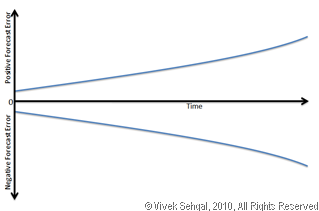Next in my series on supply chain strategy is the postponement as a strategy. Till now in this series, we have covered the lean and agile as supply chain strategies and this is the third conventional supply chain strategy I will be talking about.
The postponement strategy is based on the following two basic principles of demand forecasting. 
- The accuracy of the forecast demand decreases with an increase in the time horizon. The farther the time window for which the demand is being forecasted, the more inaccurate it will be. The figure graphically represents this effect as a funnel: as time extends farther into the future, the forecast error grows, showing that the forecast demand will have larger and larger variations as time periods progress into the future.
- Demand projections for a product group are generally more accurate than projections for individual products. For example, it is much easier to forecast the total demand for LCD TVs than it is for an individual TV of a specific brand, model, screen size, resolution, and color contrast ratio.
The postponement strategy leverages the above characteristics of demand forecasting. It dictates that the firms should postpone the creation or delivery of the final product as long as possible. For retailers, this takes the shape of postponing the delivery of the final product to its destination, while for assemble-to-order manufacturers this means postponing the final assembly of the product. For manufacturing scenarios like build-to-stock, the postponement strategy may drive pushing the packaging or final assembly of the products, allowing the manufacturer to personalize, configure finished products to customer orders, and change the final product mix to suit any changes in demand. The postponement strategy effectively reduces inventory obsolescence and takes out the risk and uncertainty costs associated with having undesirable products, but it requires an integrated and agile supply chain to ensure that the latest demand forecasts can be frequently created and propagated through the supply chain to produce or allocate the right products for their customers.
While postponement is conventionally thought of as a supply chain strategies, a little thinking will dispel this notion. Postponement is not an absolute choice, it is an imperative forced by the type of industry, assortment, and demand patterns. For example, a postponement strategy for delivering supplies to a trauma center or cereal to a grocery store are just not practical choices, even though it may allow for delivery of specific medical kits optimal for the type of trauma or the correct size of cereal packages in response to the actual demand. Therefore, medical supplies manufacturer cannot select postponement as their supply chain strategy any more than a grocer can postpone delivering their cereal. However, in few situations the production and demand patterns may allow postponement to become a business option, in which case, the supply chain must be designed to support that choice – an example is Avon as provided by Shoshanah Cohen and Joseph Roussel in their book on Strategic Supply Chain Management. Avon declined to label their bottles themselves for a long time, viewing this as additional cost and complexity. However, after developing an end-to-end supply chain visibility, Avon saw the opportunity in postponing the creation of its final product by placing the labels in the desired target language. It successfully deployed an idea that had been pushed out earlier, after understanding that this allowed them to postpone the production of final finished goods and better align their supplies to the end-demand without tremendously increasing their inventory.
The situations in which postponement may be an explicit choice to be made for a supply chain are limited, but may become real options for specific categories of products or sales channels of a company. For example, Dell has mastered the art of postponement for their custom-designed machines for individual consumers. When Dell started, this was not necessarily the case in the industry, however, Dell invented a new business model and leveraged postponement as a business model – not as a supply chain strategy – though, it then designed their supply chain to support this business model. That is the distinction I want to make clear – postponement as a business model which then drives the supply chain strategy and not the other way around. And that is also the reason for why I believe that postponement as a supply chain strategy puts the facts on their head – supply chain strategy must follow a business strategy and not the other way around!
In the next article, I will talk about the speculation as a supply chain strategy and why that too falls short of truly being a strategy for supply chains. Keep tuned!
Related Articles:
- Supply Chain Strategy: Lean and Agile at the Same Time?
- Agile as a Supply Chain Strategy
- Lean as a Supply Chain Strategy
- Supply Chain Strategies: Time to Refresh?
- Business Strategy & Supply Chains
- Business, Functional & Deployment Strategy Alignment for Supply Chains
© Vivek Sehgal, 2010, All Rights Reserved.
Want to know more about supply chains? How they work, what they afford, and how to design one? Check out my books on Supply Chain Management at Amazon.
October 29, 2010 at 10:33 pm
Hi Vivek,
The article is very informative and the examples provided were apt. There is always a tug of war between the inventory pileup and with the supply..
Thanks
Akhilesh